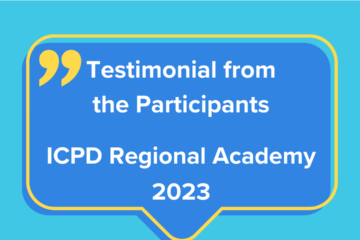
Flash-mob videos that reach 545k viewers, engaging social media influencers, vlogs that speak to the realities of young people – these were just a few examples of powerful advocacy approaches currently being used by young leaders throughout Asia to promote the need for comprehensive sexuality education.
In a region where nearly half of the world’s youth live, the reality is that many face early and unintended pregnancies, they are vulnerable to contracting HIV, and have limited access to sexual and reproductive health services. Critical to addressing these issues is the need to ensure that all young people have access to evidence-based, age-appropriate and comprehensive sexuality education.
This week, 33 young leaders representing 12 Asian countries gathered together in Bangkok to share powerful campaigns and initiatives they are organizing to promote better access to comprehensive sexuality education (CSE) – education to equip young people with the skills, knowledge and attitudes to foster healthy and respectful relationships.

This forum of advocates, organized by UNESCO and UNFPA in partnership with Y-PEER, Youth LEAD, and UNAIDS, served as an opportunity to stimulate exchanges and find areas of cooperation in advocating for quality and accessible CSE for all.

Storytelling was identified as one of the most effective ways to share campaign messages with wider audiences. Participants agreed that people tend to connect with stories on a deeper, more personal level than with facts or statistics. “The more deeply they feel an issue, the more likely people will want to take action,” said Chongzheng Wei, a Chinese trainee from UNESCO. Sandeep Nanwani, Programmer Officer from UNFPA Indonesia, cited the power of vlogs to amplify the impact of personal storytelling, sharing about a young person who opened up on YouTube to tell his story, which ultimately went viral and raised awareness about stigma, discrimination and barriers facing gay men living with HIV in Indonesia.
Crafting tailored messages for governments and other partners is instrumental to making changes to education policies and improve comprehensive sexuality education across the region. “Target the decision-makers who have the power to create changes that you aim to achieve,” said Reaksa Rom, Y-PEER Focal person in Cambodia who recognized the importance of identifying key players in a communications campaign.
Employing social media was also at the core of the conversation. “There are two key factors that contribute to the success of a social media advocacy campaign: ensuring the sustainability of an organization’s social media account; and tapping into the power of influencers, bloggers, and pop stars to increase the reach and impact of your campaign,” said Ajong Ng, from Y-PEER Thailand.
Sajja Singh, Vice President of YUWA, a youth-led organization from Nepal, explained how the group has used art for advocacy, including organizing a flash-mob dance performance to raise awareness about safe abortion. Launched as an offline event, the performance was also recorded and uploaded to YouTube, garnering more than 536,000 views.
The need for youth-led, coordinated CSE advocacy in Asia and the Pacific is urgent. This session provided a space for pioneering youth advocates to inspire and connect with their peers and foster collaborations.
By: Michela Polesana, Advocacy Advisor, UNAIDS Asia-Pacific; Hunter Gray, Programme Officer, UNESCO Bangkok; Wei Chongzheng, Trainee, UNESCO Bangkok
Main image credit: Saurav Thapa Shrestha
